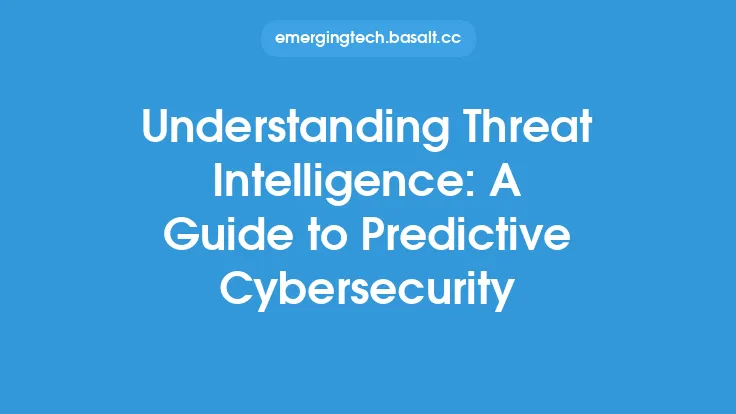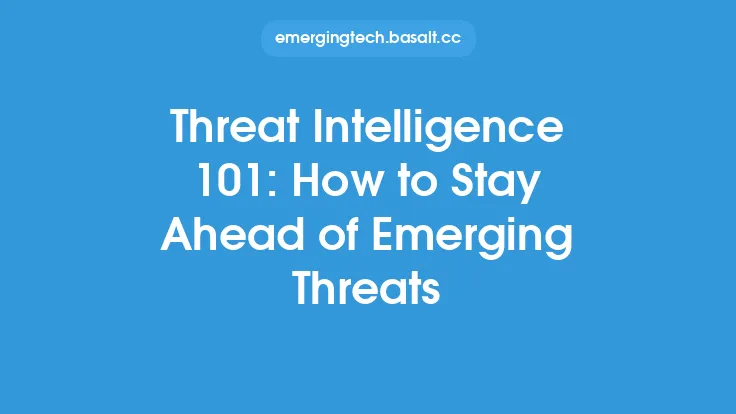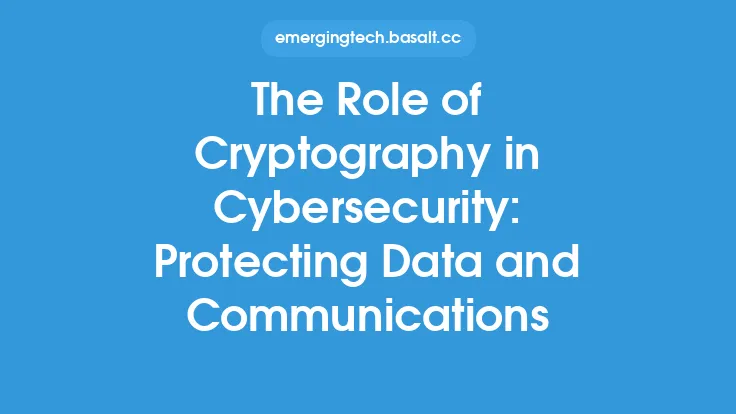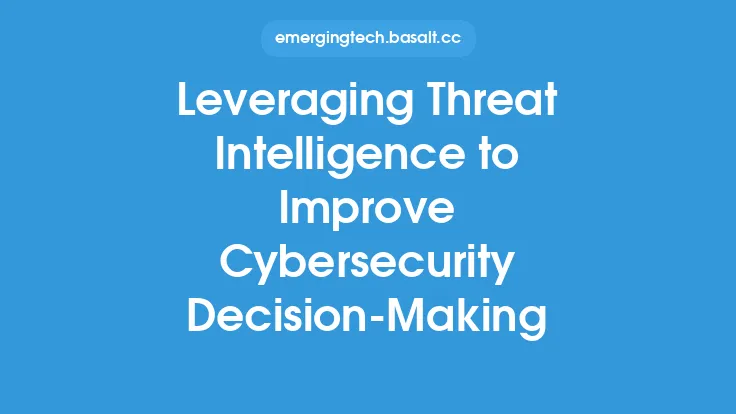Threat intelligence is a critical component of a comprehensive cybersecurity strategy, providing organizations with the necessary information to stay ahead of emerging threats and protect their networks, systems, and data from cyber attacks. At its core, threat intelligence involves the collection, analysis, and dissemination of information about potential or actual cyber threats, allowing organizations to make informed decisions about their cybersecurity posture.
Introduction to Threat Intelligence
Threat intelligence is a subset of cybersecurity that focuses on understanding the tactics, techniques, and procedures (TTPs) used by threat actors, such as hackers, nation-state actors, and cybercriminals. This information is used to anticipate and prevent cyber attacks, as well as to respond to and mitigate the impact of successful attacks. Threat intelligence can be categorized into several types, including strategic, tactical, and operational intelligence. Strategic intelligence provides high-level information about the threat landscape, while tactical intelligence focuses on specific threats and vulnerabilities. Operational intelligence, on the other hand, provides real-time information about ongoing attacks and threats.
The Threat Intelligence Lifecycle
The threat intelligence lifecycle consists of several stages, including planning and direction, collection, analysis, dissemination, and feedback. The planning and direction stage involves identifying the organization's intelligence requirements and developing a plan to collect and analyze threat intelligence. The collection stage involves gathering information from various sources, such as open-source intelligence, social media, and threat feeds. The analysis stage involves examining the collected information to identify patterns, trends, and insights about potential threats. The dissemination stage involves sharing the analyzed intelligence with relevant stakeholders, such as security teams and executives. The feedback stage involves continuously evaluating and refining the threat intelligence process to ensure that it remains effective and relevant.
Threat Intelligence Sources and Feeds
Threat intelligence sources and feeds are critical components of the threat intelligence lifecycle. These sources provide organizations with the information they need to stay informed about emerging threats and vulnerabilities. Some common sources of threat intelligence include open-source intelligence, commercial threat feeds, and government agencies. Open-source intelligence involves collecting information from publicly available sources, such as social media, blogs, and online forums. Commercial threat feeds, on the other hand, involve purchasing threat intelligence from specialized vendors. Government agencies, such as the Cybersecurity and Infrastructure Security Agency (CISA), also provide threat intelligence to organizations.
Threat Intelligence Tools and Technologies
Threat intelligence tools and technologies are used to collect, analyze, and disseminate threat intelligence. Some common tools and technologies include threat intelligence platforms, security information and event management (SIEM) systems, and intrusion detection systems (IDS). Threat intelligence platforms provide a centralized repository for storing and analyzing threat intelligence, while SIEM systems provide real-time monitoring and analysis of security-related data. IDS systems, on the other hand, detect and alert on potential security threats in real-time.
Threat Intelligence and Incident Response
Threat intelligence plays a critical role in incident response, providing organizations with the information they need to respond to and mitigate the impact of successful attacks. Incident response involves several stages, including detection, containment, eradication, recovery, and post-incident activities. Threat intelligence is used throughout these stages to inform response efforts and ensure that the organization is taking a proactive and informed approach to incident response.
Threat Intelligence and Cybersecurity Frameworks
Threat intelligence is closely tied to cybersecurity frameworks, such as the National Institute of Standards and Technology (NIST) Cybersecurity Framework. This framework provides a structured approach to managing cybersecurity risk, including identifying, protecting, detecting, responding to, and recovering from cyber threats. Threat intelligence is a critical component of this framework, providing organizations with the information they need to identify and protect against potential threats.
Challenges and Limitations of Threat Intelligence
Despite its importance, threat intelligence faces several challenges and limitations. One of the biggest challenges is the sheer volume of threat intelligence data, which can be overwhelming for organizations to collect, analyze, and disseminate. Additionally, threat intelligence requires significant resources and expertise, which can be a barrier for smaller organizations. Furthermore, threat intelligence is not a silver bullet and should be used in conjunction with other cybersecurity controls and measures.
Best Practices for Implementing Threat Intelligence
To implement threat intelligence effectively, organizations should follow several best practices. First, they should develop a clear understanding of their intelligence requirements and prioritize their threat intelligence efforts accordingly. Second, they should establish a threat intelligence team or function to collect, analyze, and disseminate threat intelligence. Third, they should invest in threat intelligence tools and technologies to support their threat intelligence efforts. Finally, they should continuously evaluate and refine their threat intelligence process to ensure that it remains effective and relevant.
Conclusion
In conclusion, threat intelligence is a critical component of a comprehensive cybersecurity strategy, providing organizations with the necessary information to stay ahead of emerging threats and protect their networks, systems, and data from cyber attacks. By understanding the threat intelligence lifecycle, sources, and feeds, as well as the tools and technologies used to collect, analyze, and disseminate threat intelligence, organizations can develop a proactive and informed approach to cybersecurity. Additionally, by following best practices for implementing threat intelligence, organizations can ensure that their threat intelligence efforts are effective and relevant, and that they are well-equipped to respond to and mitigate the impact of successful attacks.





